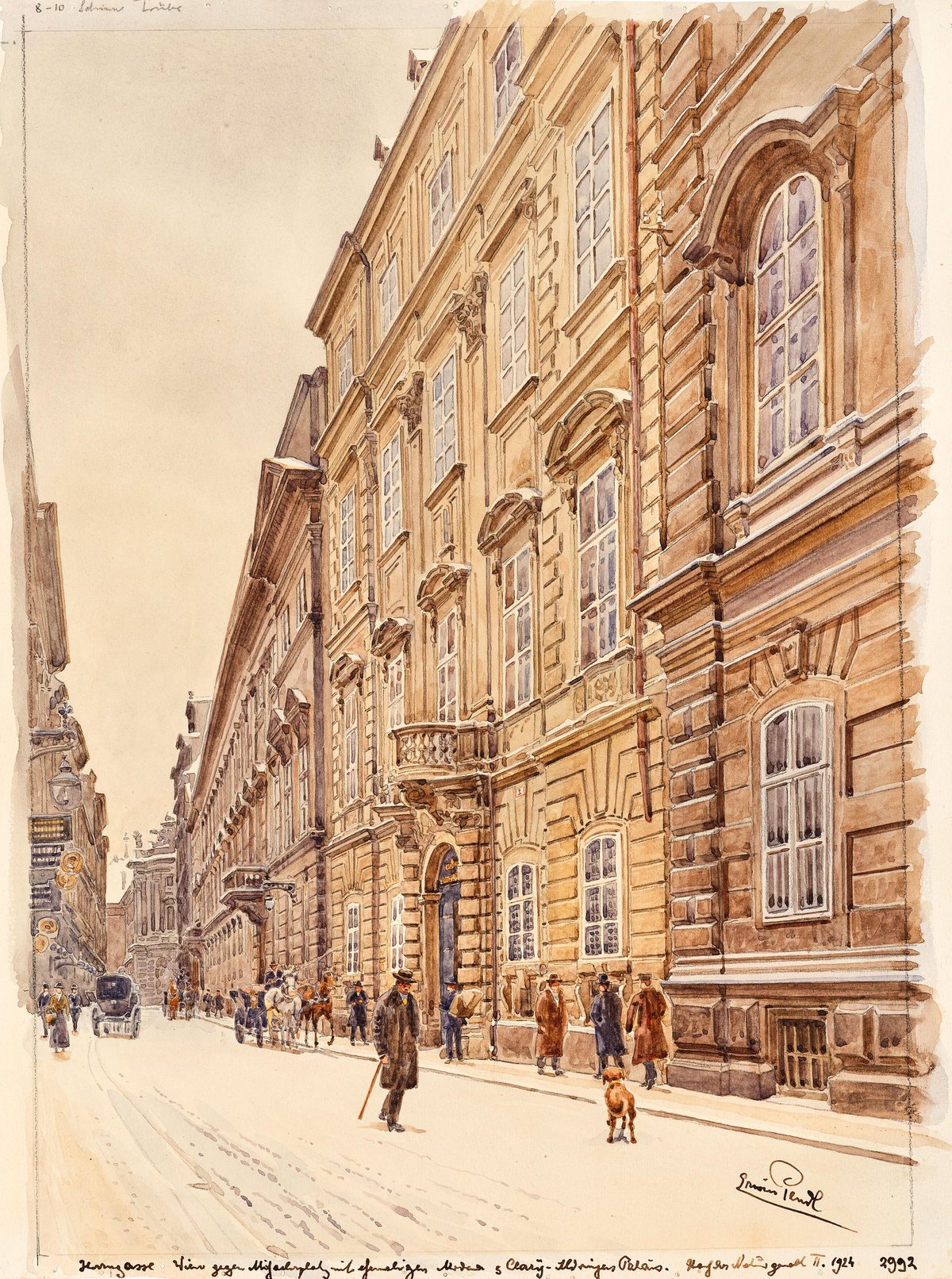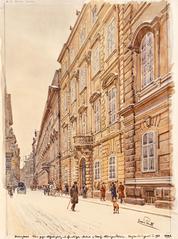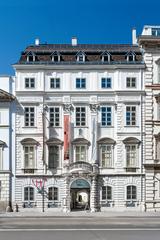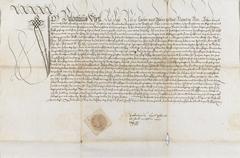
Palais Mollard-Clary Vienna Visiting Hours, Tickets, and Travel Guide
Date: 14/06/2025
Introduction
Nestled within Vienna’s historic Innere Stadt, Palais Mollard-Clary is a magnificent Baroque palace that serves as both a cultural landmark and a modern institution. Located at Herrengasse 9, this architectural gem evolved from medieval origins into a vibrant hub of history, scholarship, and art. Through centuries of transformation—especially under architect Domenico Martinelli in the late 17th century—the palace gained its grand Baroque appearance, characterized by elaborate stucco work, soaring staircases, and richly adorned interiors. Once the site of imperial salons and aristocratic gatherings, today it houses key collections of the Austrian National Library, including the world’s only public Globe Museum and the Esperanto Museum dedicated to planned languages.
This comprehensive travel guide covers Palais Mollard-Clary’s visiting hours, ticketing, accessibility, and essential travel tips. Whether you’re a history buff, an architecture enthusiast, or a curious traveler, here you’ll find everything you need for a rewarding visit to this unique Viennese institution. For official updates, refer to Austrian National Library, austriasites.com, and Wikipedia.
Contents
- Historical Overview: From Medieval Roots to Baroque Splendor
- The Clary-Aldringen Era and Intellectual Salons
- 20th–21st Century: Public Museum and National Library
- Architectural Highlights
- Visiting Information
- Opening Hours
- Tickets and Admission
- Accessibility
- Guided Tours and Special Events
- Practical Travel Tips
- Nearby Attractions
- Frequently Asked Questions (FAQ)
- Conclusion and Visitor Recommendations
- Sources and Further Reading
Historical Overview: From Medieval Roots to Baroque Splendor
Early Foundations
The site of Palais Mollard-Clary traces its origins back to around 1250, when Seifried von Mödling established the first documented structure along what became Herrengasse (austriasites.com). Close to the Minoritenkirche monastery, the property changed hands frequently, surviving the destructive fire of 1326/27, and was rebuilt and expanded over the centuries. By 1563, the estate was acquired by Peter von Mollard, whose family began transforming it into a grand residence.
Baroque Transformation
The most significant transformation occurred between 1695 and 1698, when Italian architect Domenico Martinelli was commissioned to redesign the palace in the Baroque style (Burghauptmannschaft Österreich). Martinelli’s vision brought symmetry, grandeur, and theatricality to the building: a stately façade, grand staircase, and richly decorated interiors. Ornate stucco, mythological frescoes by Andrea Lanzani, and interior enhancements by Christian Alexander Oedtl and Johann Lukas von Hildebrandt defined the palace’s new character.
The Clary-Aldringen Era and Intellectual Salons
In 1760, Count Franz Wenzel von Clary und Aldringen purchased the palace, updating ceremonial rooms and the façade with elegant pilasters (rjontour.com). The palace became a center for Vienna’s elite, hosting Emperor Joseph II’s famed “Tischrunde,” where leading aristocrats discussed politics, philosophy, and the arts (Wikipedia). This tradition fostered a culture of intellectual exchange that left a lasting mark on Vienna’s history.
The Clary family also established a significant private library and art collection, reflecting their commitment to knowledge and culture (Wikipedia).
20th–21st Century: Public Museum and National Library
Transition to Public Use
In the late 19th and early 20th centuries, Palais Mollard-Clary served diplomatic functions, hosting various embassies and legations. From 1922, it housed the Niederösterreichisches Landesmuseum, surviving wartime damage and post-war reconstruction (geschichtewiki.wien.gv.at). In 1999, the Austrian government acquired the palace, paving the way for its current role.
Austrian National Library
A major renovation from 2002 to 2005 modernized the palace for public and scholarly use (austriasites.com). Today, Palais Mollard-Clary is home to:
- Globe Museum: The only public museum dedicated to globes, with over 380 historical and scientific globes (shunculture.com).
- Esperanto Museum: Chronicling Esperanto and other planned languages, with rare books, manuscripts, and interactive displays (wien.info).
- Music Collection: One of Austria’s most important music archives, spanning several floors (Wikipedia).
Architectural Highlights
Palais Mollard-Clary exemplifies Baroque sophistication, with a harmonious, symmetrical façade, a ceremonial arched portal, and ornamentation that signals the importance of the piano nobile (main floor). The grand staircase—with sweeping balustrades and dramatic lighting—serves as both a functional and theatrical centerpiece (planet-vienna.com). Interiors feature mythological frescoes, gilded moldings, and marble columns, creating an atmosphere of intellectual grandeur.
Notable rooms include the Hall of Maps (Kartensaal), housing the National Library’s map collection, and the former state apartments, used for special exhibitions and events.
Visiting Information
Opening Hours
- Tuesday to Sunday: 10:00 AM – 6:00 PM
- Closed: Mondays and public holidays
(Austrian National Library – Visitor Information)
Tickets and Admission
- General admission: €8 (for the Globe or Esperanto Museum)
- Students, seniors, groups: €6
- Children under 19: Free
- Combined tickets: Available for both museums
- Vienna Pass holders: Free entry
Tickets can be purchased online or at the entrance (Austrian National Library – Visitor Information).
Accessibility
- Fully wheelchair accessible (elevators, ramps)
- Accessible restrooms
- Assistance available upon prior request
Guided Tours and Special Events
- Regular guided tours (German/English) focusing on architecture, collections, and specific themes
- Group tours and educational workshops available by advance booking
- Special exhibitions and events throughout the year; check the official website for updates
Practical Travel Tips
- Photography: Non-flash photography permitted; restrictions may apply to specific exhibits
- Cloakroom: Large bags must be checked
- Language: Exhibit labels in German and English; staff fluent in English
- Best time to visit: Weekday mornings for a quieter experience; June is ideal for pleasant weather
Nearby Attractions
Palais Mollard-Clary is moments from key Vienna landmarks:
- Hofburg Palace
- Volksgarten
- Spanish Riding School
- Kunsthistorisches Museum
- Vienna State Opera
Its central location and proximity to public transport make it easy to combine your visit with a walking tour of Vienna’s historic center (Google Maps).
Frequently Asked Questions (FAQ)
Q: Where is Palais Mollard-Clary located?
A: Herrengasse 9, 1010 Vienna, Austria.
Q: What are the visiting hours?
A: Tuesday to Sunday, 10:00 AM – 6:00 PM; closed Mondays and holidays.
Q: How much does admission cost?
A: €8 for adults; €6 for students/seniors/groups; free for children under 19.
Q: Is the palace wheelchair accessible?
A: Yes, with ramps, elevators, and accessible facilities.
Q: Are guided tours available?
A: Yes, in German and English; advance booking recommended for groups.
Q: Is photography allowed?
A: Non-flash photography is permitted in most areas.
Q: Can I buy tickets online?
A: Yes, via the Austrian National Library website.
Conclusion and Visitor Recommendations
Palais Mollard-Clary is more than a stunning Baroque palace—it is a living testament to Vienna’s intellectual, cultural, and architectural legacy. From its medieval roots and aristocratic salons to its current role as a public museum and research library, the palace bridges centuries of European history. Visitors will find world-class collections, beautifully preserved architecture, and a welcoming atmosphere for both scholarly exploration and leisurely visits.
To make the most of your visit, consult the Austrian National Library’s official information, and consider combining your trip with nearby Viennese landmarks. Download the Audiala app for self-guided tours and follow trusted sources for updates on exhibitions and special events.
Sources and Further Reading
- austriasites.com
- Burghauptmannschaft Österreich
- Wikipedia
- cordmagazine.com
- Austrian National Library – Visitor Information
- Globe Museum
- Esperanto Museum
- Travel Melodies
- Trek.zone
- RJ On Tour
- shunculture.com
- wien.info
























































































































































